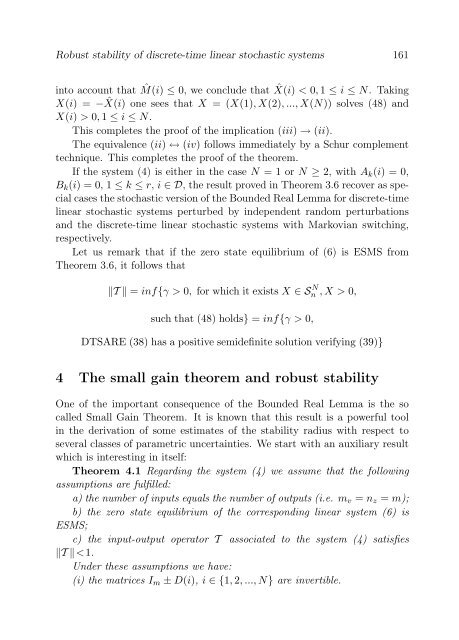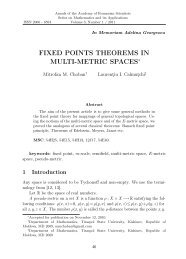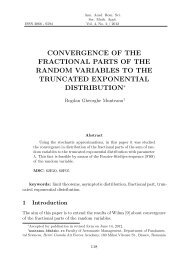160 Vasile Dragan, Toader Morozan1 ≤ i ≤ N. One can sees that (55) is a nonlinear equation of type (41) defined( ) ˆMby the pair Σ = (Π, ˆQ) with ˆQˆL=ˆL T ∈ Sn+m ˆRN v. One can checkthat if X = (X(1), X(2), ..., X(N)) solves (48) then ˆX = ( ˆX(1), ..., ˆX(N))with ˆX(i) = −X(i), i ∈ D solves the corresponding LMIs (46).Also if (ii) is fulfilled then from (1,1) block of (48) one obtains thatΠ 1i X − X(i) < 0, 1 ≤ i ≤ N. Using the implication (vii) → (i) of Theorem3.4 in [7] in the special case of the positive operator Π 1 we deduce that theeigenvalues of this operator are located in the inside(of the disc |λ| < 1.)Π1 X ΠThis means that the operator Π defined by ΠX =2 X(Π 2 X) T Π 3 Xis stabilizable (in the sense of Definition 3.1 from above). Thus we obtainthat if (ii) is fulfilled then in the case of DTSGRE (55) the assertion (i)in Theorem 3.5 is fulfilled. Hence, (55) has a stabilizing solution X s =(X s (1), X s (2), ..., X s (N)) which satisfiesΠ 3i X s − R(i) > 0, 1 ≤ i ≤ N.x (56)A simple computation shows that ˜X = ( ˜X(1), ..., ˜X(N)) defined by ˜X(i) =−X s (i) is the stabilizing solution of DTSARE (38) which satisfies (39). Sincethe eigenvalues of the positive operator Π 1 are located in the inside of thedisk |λ| < 1 from Theorem 3.5 in [7] it follows that ˜X(i) ≥ 0, i ∈ D <strong>and</strong> then(ii) → (iii) is true.Conversely, let ˜X = ( ˜X(1), ..., ˜X(N)) be the stabilizing solution of theDTSARE (38) which satisfies (39). If X s (i) = − ˜X(i), 1 ≤ i ≤ N, thenX s = (X s (1), ..., X s (N)) is the stabilizing solution of (55) which satisfies thecondition (56). Applying Theorem 3.5 in the case of (55) one deduces thatthere exists ˆX = ( ˆX(1), ..., ˆX(N)) which solves( )Π1i ˆX − ˆX(i) + ˆM(i) Π2i ˆX + ˆL(i)(Π 2i ˆX + ˆL(i))T> 0, 1 ≤ i ≤ N. (57)Π 3i ˆX + ˆR(i)On the other h<strong>and</strong> from Proposition 5.1 in [10] we deduce that X s coincideswith the maximal solution of (55). Therefore, ˆX(i) ≤ Xs (i) = − ˜X(i) ≤0, 1 ≤ i ≤ N.Let ∆ i ( ˆX) be defined by ∆ i ( ˆX) = Π 1i ˆX − ˆX(i) + ˆM(i). Since ∆i ( ˆX)is the (1,1) block of the matrix from the left h<strong>and</strong> side of (57) we have∆ i ( ˆX) > 0, 1 ≤ i ≤ N. Writing ˆX(i) = Π 1i ˆX + ˆM(i) − ∆i ( ˆX) <strong>and</strong> taking
Robust stability of discrete-time linear stochastic systems 161into account that ˆM(i) ≤ 0, we conclude that ˆX(i) < 0, 1 ≤ i ≤ N. TakingX(i) = − ˆX(i) one sees that X = (X(1), X(2), ..., X(N)) solves (48) <strong>and</strong>X(i) > 0, 1 ≤ i ≤ N.This completes the proof of the implication (iii) → (ii).The equivalence (ii) ↔ (iv) follows immediately by a Schur complementtechnique. This completes the proof of the theorem.If the system (4) is either in the case N = 1 or N ≥ 2, with A k (i) = 0,B k (i) = 0, 1 ≤ k ≤ r, i ∈ D, the result proved in Theorem 3.6 recover as specialcases the stochastic version of the Bounded Real Lemma for discrete-timelinear stochastic systems perturbed by independent r<strong>and</strong>om perturbations<strong>and</strong> the discrete-time linear stochastic systems with Markovian switching,respectively.Let us remark that if the zero state equilibrium of (6) is ESMS fromTheorem 3.6, it follows that‖T ‖ = inf{γ > 0, for which it exists X ∈ S N n , X > 0,such that (48) holds} = inf{γ > 0,DTSARE (38) has a positive semidefinite solution verifying (39)}4 The small gain theorem <strong>and</strong> robust stabilityOne of the important consequence of the Bounded Real Lemma is the socalled Small Gain Theorem. It is known that this result is a powerful toolin the derivation of some estimates of the stability radius with respect toseveral classes of parametric uncertainties. We start with an auxiliary resultwhich is interesting in <strong>its</strong>elf:Theorem 4.1 Regarding the system (4) we assume that the followingassumptions are fulfilled:a) the number of inputs equals the number of outputs (i.e. m v = n z = m);b) the zero state equilibrium of the corresponding linear system (6) isESMS;c) the input-output operator T associated to the system (4) satisfies‖T ‖
- Page 1: ACADEMY OF ROMANIAN SCIENTISTSANNAL
- Page 4 and 5: Annals of the Academyof Romanian Sc
- Page 7 and 8: Annals of the Academy of Romanian S
- Page 9 and 10: Concepts of dichotomy in Banach spa
- Page 11 and 12: Concepts of dichotomy in Banach spa
- Page 13 and 14: Concepts of dichotomy in Banach spa
- Page 15 and 16: Concepts of dichotomy in Banach spa
- Page 17 and 18: Concepts of dichotomy in Banach spa
- Page 19 and 20: Concepts of dichotomy in Banach spa
- Page 21 and 22: Concepts of dichotomy in Banach spa
- Page 23 and 24: Annals of the Academy of Romanian S
- Page 25 and 26: Robust stability of discrete-time l
- Page 27 and 28: Robust stability of discrete-time l
- Page 29 and 30: Robust stability of discrete-time l
- Page 32 and 33: 150 Vasile Dragan, Toader MorozanWe
- Page 34 and 35: 152 Vasile Dragan, Toader Morozanha
- Page 36 and 37: 154 Vasile Dragan, Toader MorozanLe
- Page 38 and 39: 156 Vasile Dragan, Toader MorozanBe
- Page 40 and 41: 158 Vasile Dragan, Toader Morozanwh
- Page 44 and 45: 162 Vasile Dragan, Toader Morozan(i
- Page 46 and 47: 164 Vasile Dragan, Toader MorozanWe
- Page 48 and 49: 166 Vasile Dragan, Toader Morozanth
- Page 50 and 51: 168 Vasile Dragan, Toader Morozan)w
- Page 52 and 53: 170 Vasile Dragan, Toader Morozan[1
- Page 54 and 55: 172 Peter Philipkeywords: nonlinear
- Page 56 and 57: 174 Peter PhilipΩ g,3Ω sΩ sΩ g,
- Page 58 and 59: 176 Peter Philipusing the nonlocal
- Page 60 and 61: 178 Peter Philipsuch that (3) becom
- Page 62 and 63: 180 Peter PhilipDenition 8. Assume
- Page 64 and 65: 182 Peter Philip(b) If f ∈ L 1 (
- Page 66 and 67: 184 Peter Philipare related to weak
- Page 68 and 69: 186 Peter Philip(A-18) ɛ : Σ −
- Page 70 and 71: 188 Peter Philipω s,1 ω s,1ω s,1
- Page 72 and 73: 190 Peter PhilipThe approximation o
- Page 74 and 75: 192 Peter Philipvector ⃗u := (θ
- Page 76 and 77: 194 Peter Philip4.4 The Finite Volu
- Page 78 and 79: 196 Peter PhilipGeometry Temperatur
- Page 80 and 81: 198 Peter Philipdirectly as in (28)
- Page 82 and 83: 200 Peter Philiptimized solutions s
- Page 84 and 85: 202 Peter Philip[16] P.-É. Druet a
- Page 86 and 87: 204 Peter PhilipProceedings of the
- Page 88 and 89: 206 Nicolae Cîndea, Marius Tucsnak
- Page 90 and 91: 208 Nicolae Cîndea, Marius Tucsnak
- Page 92 and 93:
210 Nicolae Cîndea, Marius Tucsnak
- Page 94 and 95:
212 Nicolae Cîndea, Marius Tucsnak
- Page 96 and 97:
214 Nicolae Cîndea, Marius Tucsnak
- Page 98 and 99:
216 Nicolae Cîndea, Marius Tucsnak
- Page 100 and 101:
218 Nicolae Cîndea, Marius Tucsnak
- Page 102 and 103:
220 Nicolae Cîndea, Marius Tucsnak
- Page 104 and 105:
Annals of the Academy of Romanian S
- Page 106 and 107:
224 Klaus Krumbiegel, Ira Neitzel,
- Page 108 and 109:
226 Klaus Krumbiegel, Ira Neitzel,
- Page 110 and 111:
228 Klaus Krumbiegel, Ira Neitzel,
- Page 112 and 113:
230 Klaus Krumbiegel, Ira Neitzel,
- Page 114 and 115:
232 Klaus Krumbiegel, Ira Neitzel,
- Page 117 and 118:
Sufficient optimality conditions fo
- Page 119 and 120:
Sufficient optimality conditions fo
- Page 121 and 122:
Sufficient optimality conditions fo
- Page 123 and 124:
Sufficient optimality conditions fo
- Page 125 and 126:
Sufficient optimality conditions fo
- Page 127 and 128:
Sufficient optimality conditions fo
- Page 129 and 130:
INFORMATION FOR AUTHORSSUBMITTING M






